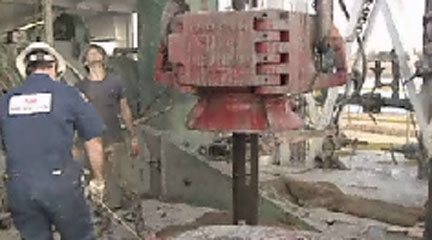HOUSTON The BP catastrophe in the Gulf of Mexico is highlighting the risks faced by drilling rig workers, who have one of the most dangerous jobs in the nation. The explosion on the Deepwater Horizon rig on April 20 killed 11 crew members.
Across the nation, drilling activity has been increasing in the last few years, and so have fatalities, according the government.
The death rate for drilling workers is eight times the national average for all workers: 31 deaths per 100,000 oilfield workers compared to 4 deaths per 100,000 workers in all industries, according toBureau of Labor Statistics data from 2003-2007.
One of the riskiest jobs is being a roughneck, the rig workers who typically put in 12-hour days on the rig floor.
It s dirty and it s rough, said Tyler Langford , who now manages drilling rigs for a company called Petrohawk Energy, which has offices in downtown Houston. A few years ago, Langford worked on rigs as a roughneck.
You re picking up the pipe physically, making it up to the next joint so you can keep drilling.
Langford said.
In his time as a roughneck, no one got seriously hurt and there were never any blowouts on the offshore rigs where he worked.
Thank God I ve never seen a blowout in person, Langford said.
But there the accidents do happen, and some are being caught on video.
On websites including Roughneck City.com, which is run by a driller in Oklahoma there are videos of wells blowing out, roughnecks getting blown off their feet or getting caught in cables and hoisted off the ground. Other videos show equipment that weighs tons crashing from high up on the rig tower and plummeting to the rig floor.
One of scariest videos is of an oil well blowout apparently overseas. Shot with a cell phone camera, it shows dozens of feet of the steel pipe that should be going down into the well instead getting blown upward.
The rig crew members run for their lives as the pipe becomes a giant, steel whip, careening around the rig tower.
The majority of accidents will happen when you re trippin pipe, said Langford.
He explained that trippin is what roughnecks call the procedure of pulling pipe out of or pushing it into the well. The procedure involves them straddling the pipe and grabbing it with huge, hydraulic tongs.
It s what roughnecks appear to be doing in one video of an accident on a rig in Colorado. Suddenly, as the roughneck grabs the pipe, high-pressure mud shoots out, instantly blasting the roughneck across the floor of the derrick.
In 2008, the U.S. Senate s Health, Education, Labor and Pensions Committee highlighted the dangers of drilling in a report titled Discounting Death; OSHA s Failure to Punish Safety Violations That Kill Workers.
One company the report singled out was Patterson-UTI Drilling, ranked as the most active drilling company in the nation by RigData.com. Its parent company has corporate offices in the Greenspoint area of north Houston.
The 2008 report said 13 workers had been killed at Patterson-UTI worksites since 2003 in the state of Texas alone.
Among the causes of the deaths were electrocution, falls, getting hit with pressurized mud and gas, and being cut into two pieces by machinery.
The Senate report criticized government regulators for not cracking down harder on the company.
11 News talked with a Patterson-UTI executive by phone but didn t get a response to questions about the report. In 2008, Patterson-UTI told the Associated Press it had spent over $1 billion to improve safety, and that accidents were decreasing.
But now, with BP s catastrophe in the Gulf, all companies involved in oil and gas drilling can expect to face new scrutiny of the risks faced by rig workers.


